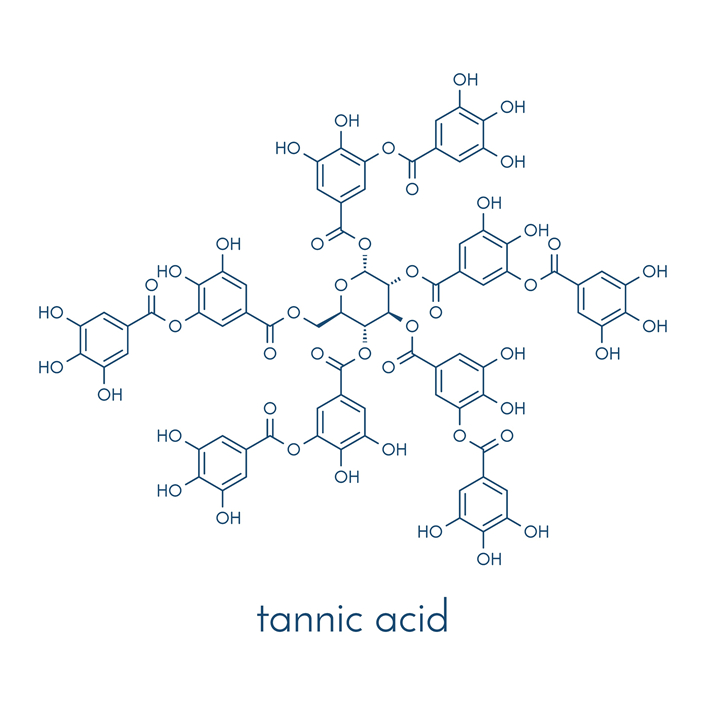
Tannic acid
Scientific names: Tannic acid
Alternate names: Acide Tannique, Ácido Tánico
Background
Tannic acid is found in the nutgalls formed by insects on the twigs of certain oak trees. Purified tannic acid is sometimes used as medicine.
People use tannic acid for conditions such as cold sores, diaper rash, heat rash, and many others, but there is no good scientific evidence to support these uses.
In foods and beverages, tannic acid is used as a flavoring agent.
In manufacturing, tannic acid is used in ointments and suppositories; for tanning hides and manufacturing ink; and to kill dust mites on furniture.
People use tannic acid for conditions such as cold sores, diaper rash, heat rash, and many others, but there is no good scientific evidence to support these uses.
In foods and beverages, tannic acid is used as a flavoring agent.
In manufacturing, tannic acid is used in ointments and suppositories; for tanning hides and manufacturing ink; and to kill dust mites on furniture.
Safety Safety definitions
When taken by mouth: Tannic acid is LIKELY SAFE when used in the amounts found in foods. There isn't enough reliable information to know if it is safe when used in larger, medicinal amounts. Very large amounts of tannic acid can cause stomach irritation, nausea, and vomiting.
When applied to the skin: Tannic acid is POSSIBLY UNSAFE when applied to skin that is tender or damaged. There isn't enough reliable information to know if tannic acid is safe to use on healthy, undamaged skin.
Skin conditions: Don't take a bath with added tannic acid if you have weeping eczema and extensive skin damage. The broken skin could allow too much tannic acid to get into your body.
When applied to the skin: Tannic acid is POSSIBLY UNSAFE when applied to skin that is tender or damaged. There isn't enough reliable information to know if tannic acid is safe to use on healthy, undamaged skin.
Special Precautions & Warnings:
Pregnancy and breast-feeding: It's POSSIBLY UNSAFE to apply tannic acid to tender or damaged skin. There is concern that it might be absorbed and cause harmful side effects. There isn't enough reliable information to know if tannic acid is safe to take by mouth when pregnant or breast-feeding. Stay on the safe side and avoid use.Skin conditions: Don't take a bath with added tannic acid if you have weeping eczema and extensive skin damage. The broken skin could allow too much tannic acid to get into your body.
Effectiveness
NatMed Pro rates effectiveness based on scientific evidence according to the following scale: Effective, Likely Effective, Possibly Effective, Possibly Ineffective, Likely Ineffective, Ineffective, and Insufficient Evidence to Rate.
Possibly ineffective Effectiveness definitions
- Burns. Applying tannic acid to the skin does not seem to work for minor burns or sunburns.
- Diaper rash. Applying tannic acid to the skin does not seem to work for diaper rash.
- Cold sores (herpes labialis). Applying tannic acid to the skin does not seem to work for cold sores.
- Heat rash. Applying tannic acid to the skin does not seem to work for heat rash.
Insufficient evidence Effectiveness definitions
- Diarrhea. Early research shows that taking a product containing tannic acid and gelatin (gelatin tannate) might improve symptoms in children who have had diarrhea for no more than 3 days. But not all research agrees.
- Excessive sweating (hyperhidrosis). Early research shows that applying tannic acid to the palms might not work as well as iontophoresis, an electricity treatment, for reducing excessive sweating on the palms of the hand.
- Osteoarthritis.
- Cancer.
- Swollen tonsils.
- Ingrown toenails.
- Poison ivy.
- Thinning gums.
- Sore throat.
- Other conditions.
Dosing & administration
The appropriate dose of tannic acid depends on several factors such as the user's age, health, and several other conditions. At this time there is not enough scientific information to determine an appropriate range of doses for tannic acid. Keep in mind that natural products are not always necessarily safe and dosages can be important. Be sure to follow relevant directions on product labels and consult your pharmacist or physician or other healthcare professional before using.
Interactions with pharmaceuticals
It is not known if Tannic acid interacts with any medicines. Before taking Tannic acid, talk with your healthcare professional if you take any medications.
Interactions with herbs & supplements
Iron: Taking tannic acid by mouth along with an iron supplement reduces the amount of iron the body can absorb.
Interactions with foods
There are no known interactions with foods.
Action
Tannic acid contains ingredients that have a protective effect on the skin.
vital.ly has licensed monographs from TRC Healthcare.
This monograph was last reviewed on 07/04/2025 10:00:00 and last updated on 20/12/2021 08:51:11. Monographs are reviewed and/or updated multiple times per month and at least once per year.
Natural Medicines disclaims any responsibility related to medical consequences of using any medical product. Effort is made to ensure that the information contained in this monograph is accurate at the time it was published. Consumers and medical professionals who consult this monograph are cautioned that any medical or product related decision is the sole responsibility of the consumer and/or the health care professional. A legal License Agreement sets limitations on downloading, storing, or printing content from this Database. No reproduction of this monograph or any content from this Database is permitted without written permission from the publisher. It is unlawful to download, store, or distribute content from this site.




